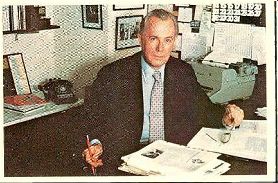
by WILLIAM ANDERSON
FISHER HALL: A VERY PALPABLE HIT
FOR at least as long as we've been able to count, mankind has been fond of the mystical number three: three Graces, three Fates, three Furies, the Trinity in several religions and three strikes in the game of baseball. That last, though it may sit a little oddly in the con text, is an example of a particularly powerful notion: a cat may have nine lives, but it seems to be a firm rule that three strikes is all the rest of us get (maybe all we deserve) whatever the game may be.
The building of multimillion -dollar concert halls is certainly far from being a "game," but when the Lincoln Center for the Performing Arts announced last spring that Avery Fisher Hall was to undergo another revamping over the summer months to correct its notoriously unprepossessing acoustics, no one doubted that this was the hall's third and last chance.
Music Editor James Goodfriend covered the matter of that announcement in his "Going on Record" column in July. The hall reopened on schedule October 19, and no one has been able to see the smiles for the canary feathers since. To be brief, the consensus of amateurs and professionals alike is that Fisher Hall looks good, feels good, and sounds good.
Even before the inaugural concert started, the very timbre of the audience's excited chatter hinted that something new was going on psychoacoustically. Despite its still -impressive size, the hall seemed warmer, more inviting, more intimate than before; gone was the off-putting coldness of the old hall, the funnel/tunnel/isolation-chamber effects, the cotton-in-the-ears dead spots, the unpredictable vagaries of frequency response. The concert began with The Star Spangled Banner, hardly a piece to judge any hall by, but it did indicate how high enthusiasm was already running-even the monotones sang out like Baby June.
Next came Nathan Milstein, soloist in the Brahms Violin Concerto, a work I usually think of, in my accustomed synaesthetic style, as a very ripe Burgundy, garnet -red and glowing richly like heavy velvet. But Milstein's Brahms comes out of another bottle entirely, for the limpid, patrician clarity of his tone put me more in mind of silks, satins, and golden Moselles. Interestingly, this comes very close to the language I would use to de scribe the hall's new acoustics: bright, clear, sparkling, a shortish reverberation time, and an evenly distributed frequency response with the suggestion of a dip on the bass end.
My seat was center -orchestra, and reports from some other ears I trust indicate that bass response is richer in the first -tier balcony seats. Which is as it should be: any concert hall in a position to brag about its sound ought to offer some slight variations for the benefit of different palates. After intermission came Stravinsky's Firebird, reinforcing the' impression made by the Brahms: this is a hall in which you can hear everything-murk, mud, and mumble have been banished and clarity, cleanliness, and articulation have taken their place.
Non -New Yorkers will not be getting a chance to hear what the hall sounds like as soon as some might like: a recording program will require considerable preparations, an enlarged stage area and a period of careful experimentation among them. But maybe that's only ironic justice: the Philharmonic's 'live" patrons are just now beginning to enjoy a sound quality previously available only to buyers of its recordings.
REGULAR readers will note the absence this month of Martin Bookspan's "Basic Repertoire" and Irving Kolodin's "Choosing Sides" columns. Reader interest in the Basic Rep has declined of late, and we think we know why: how "basic" can a list 180 -odd items long be? We will therefore be trying a new tack in this area, covering some of the old ground-and some new as well-with "Basic Library" articles. We have put Mr. Kolodin to work on some of these; his piece on the Mahler symphonies in October was the first, and he has already worked up another, a Basic Library of Chamber Music which will appear in an early issue. Also in the works is Richard Freed's annual updating of The Whole Basic Rep; watch for the announcement in a month or so.
Also see:
NEW PRODUCTS: Roundup of latest audio equipment and accessories
LETTERS TO THE EDITOR (Feb 1977)
Source: Stereo Review (USA magazine)